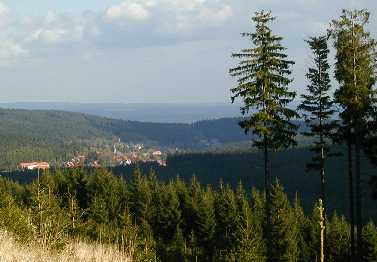Forestry in Germany
4. The development of a sustainable forestry based on the needs of mining
| The development of a sustainable forest production on a scientific basis began in Germany nearly 300 years ago. One main driving force for this was mining. The ruling nobles became aware that the production of gold, silver, copper and salt was strongly related to the availability of timber and fuelwood. So they startet to consider forests not only as hunting grounds but also as sources of wealth and income. The first schools of forestry therefore were founded in mining regions as in Ilsenburg (Hartz-mountains) 1763. |

|
"The principle of sustained yield was originally based on the realization that the amount of wood a forest can supply is not inexhaustible. It may only be utilized on a scale which corresponds to its natural rate of growth, if a continuous and permanent wood harvest of roughly constant volume is to be assured. From the very beginning of forest planning, this basic idea played a decisive role. At the end of the 18th century it found expression in the classic formulation of G.L.HARTIG (1764-1837): "All wise forest management must ... have woodland valued ... and endevour to utilize them as much as possible, but in such a way that later generations will be able to derive at least as much benefit from them as the present generation claims for itsself." The concept of sustained yield and permanence, which was formerly applied only to the production of timber, has since been extended to cover all the functions of the forest, that is to say its commercial, protective and recreational functions, and is the guiding principle of all forest measures."
(KLOSE 1985: A brief history of the German forest - achievements and mistakes down to the ages. What lessons can be learned for forestry in developing countries? edited by GTZ)
 |
Before the "industrial revolution" began Germany was widely deforested. During the last 200 centuries foresters "rebuilt" the forests. Since then spruce (picea abies; see left) are dominating most mountainous areas in Germany. |
| In northern and eastern Germany and on poorer soils in southern Germany pine stands (pinus sylvestris) were planted. Here up to the 19th century sods from the woods had been used as fertilizer for corn-growing and mainly sheep and goat grazing destroyed the regeneration of forest trees. That on sandy sites led to the development of an infertile heathland or even sanddunes. |
|
A basic precondition for a sustainable timber production was the measurement of forest areas and trees. Several sciences started to deal with forestry matters. Finally Germany became the cradle of forest sciences. The sucess of the reafforestion and conservation efforts was obvious. Many pioneers went other countries all over the world and initiated or influenced the development of forestry and forest services there. Famous examples are:
Heinrich David Wilckens (1763-1832) became the first Professor for forestry in Schemnitz (Hungary; today: Banská Stiávnica / Slovakia).
Carl Ludwig Obbarius (1780-1860) was a forest warden from theHartz mountains and disciple of Hartig and Cotta. He was appointed to build up a forest school of the ore companies in Schweden and directed it almost until his death in 1860.
(BRYNTE, B. 2002: C.L. Obbarius - ein deutscher Pionier in schwedischen Wäldern. Forst und Holz 57 (12), 395-4ß2)
Next page: Actual trends in German forestry as increasing the proportion of hardwoods, mixed and uneven aged stands due to ecological and economical reasons
|



